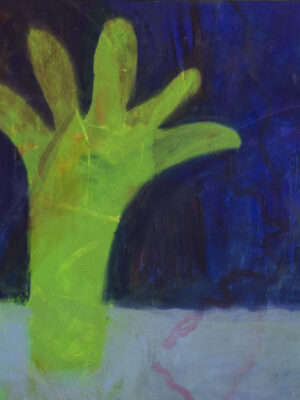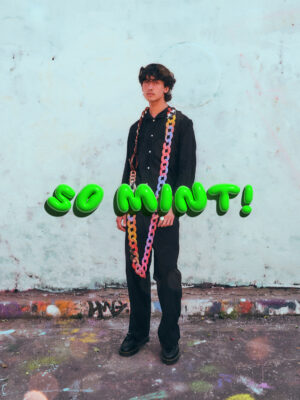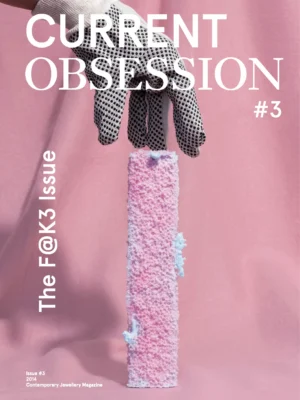


C.O.:
Do you think there is a reason we always turn to the iconic forms of jewellery?
L.C.:
I use archetypal jewellery forms in my work as a basic language with which to build a conversation about jewellery. By borrowing and referencing the familiar shapes of lockets, rings and necklaces, I am priming the pieces ready to receive an idea, a≈thought, an observation. They are visual cues indicating I am commenting on
something I’ve noticed about jewellery – the subject of jewellery and the possibilities that surround the jewel – and not the jewel itself.
These conventional forms were rejected by the radical New Jewellery movement of the 70s and 80s in favour of more expressive and experimental forms of jewellery.
Recently, they have crept back into play and not without the blessing of some of the key exponents of the New Jewellery movement. A new generation of makers are reevaluating and repositioning these iconic forms at the core of their work from which to build their ideas. Inside every piece of contemporary jewellery can be found the DNA of its archetypal ancestor. A self-referential ‘jewellery language’ is developing
and as a result is perhaps less concerned about what jewellery is, but exploring instead what is it doing, where is it, what is it saying, who does it belong to and why. These forms are alluring because they seem like the ‘beginnings of jewellery’, starting points devoid of any apparent design, year of manufacture or makers marks and the essence of them have not changed since humans first started to wear objects of significance.
They represent an almost perfectly a fascination I have with the basic principle of a jewellery object: a blank foundation upon which I can express ideas confidently – unhindered by unnecessary concerns of colour and material choices, considerations of scale and aesthetics that all serve to divert attention elsewhere, somewhere I do not intend the idea to go. I feel if I stray too far from the language of these forms,
I risk losing the point I’m making about jewellery.
These ubiquitous forms do have further uses: everyone recognizes them as jewellery. Whether expert or novice, everyone is welcome to form an opinion, to join in on an ongoing conversation about jewellery. In fact, individual experiences of these forms of jewellery, however limited, are essential in the interpretation of some of the work.
C.O.:
Can you talk about the trinity of concept/form/material in the development of your work? How do these precede each other? Your work is refined to the point where the concept meets the chosen form and they come together in the “perfect” material in order to communicate something you envisioned — the reading of the piece is very precise — no mistake could be made. The meeting point of these three (concept/form/material) is where your jewellery resides.
L.C.:
An interesting aspect of jewellery – and here, I am really talking about the jewellery that is out there in the world, being bought and worn on a daily basis, untouchable by the jewellery artist or contemporary maker – is that on the surface of it the forms are not that remarkable, boring even. You could argue that a ring from one high street store is more or less the same as a ring in any other store. Even so, if you ask two different people that have bought the same piece, you get two different stories. Knowing that a jewellery object is not unique, mass produced in fact, doesn’t spoil the enjoyment of it or the trust in it becoming special to the people that buy and wear it. The circumstances that surround choice and choosing, the means of purchase or acquisition, the timing, the place of exchange, the ritual of gifting can all influence and define that object, giving it its distinct meaning and value. The objects are unique simply because we are unique. This is a very powerful concept for any object to behold and even more so if we all uphold it. This hidden narrative is essential in driving my imagination and this is what I try to express in the pieces I make. Almost every piece starts with an idea, then form, then material, in that order and it rarely gets reshuffled. I find it hard to make without a reason to. I can of course, always find a reason to make; it is the good ones that often elude me!
C.O.:
Completeness is obviously an important part of your work. In the later works you search for a completion of the possibility, becoming almost obsessive in a peculiar way. Does it have to do with perfectionism? 24 carats of gold, Wedding rings for the average man and woman – both these works demonstrate every single variation of a universal idea.
L.C.:
I do like being thorough and consequently, I often revisit ideas. Because I am too easily driven by ideas and tend to have lots of them, I try to make it a rule not to turn over too many but instead I try to refine, perfect and reiterate ongoing concerns. I know there is not always one answer and in making further iterations, I can say things slightly differently, in another tone, from another perspective. When I think about something long enough, there always are more possibilities not less. The more I reduce and distill, the more nuanced an idea becomes and this subtlety is important to explore especially if something is hard to say or pin point. Wedding rings for the average man and woman (UK size) is a recent example in a long line of works that continually explores ideas around something being ‘uniquely average’ or ‘averagely unique’. In this example it comments on two objects that on the one hand are expected to fulfill their role as wholly unique items for a bride and groom but ironically because of their ‘average’ size, are produced in an abundance to facilitate this.



C.O.:
In discussing jewellery we are also talking about objects imbued with meaning. We carry these things around with us, they are gifts from loved ones; they are relics of our family past, soon to be passed onto the future.
What is it that jewellery possesses to become such objects?
L.C.: Jewellery more than any other object I can think of, is the closest example of something that represents both a person’s identity and their soul and not surprisingly we associate jewellery objects easily to a person, real or imagined. Jewellery is not for something; it is for and of someone.
Firstly, there is no mistaking jewellery’s corporeal relationship to a person; a hole for a finger – a particular finger and not any finger; a chain only makes sense as it becomes a necklace around a neck; the pin of an earring is intimately hidden within the body and silver has the highest thermal conductivity of any metal and warms itself instantly to body temperature against the skin. We can recognize someone through their jewellery as easily as we recognize their gait, their voice, their hairstyle, it becomes part of them; the person and the jewellery are inextricable.
Secondly, jewellery is innocent and it is the consummate, blank object that exists without prejudice, bias or function so as to be able to accommodate all manner of significance and meaning we can, at will, bestow on it. This is its function and because it is not judged on how well or how effectively it performs this role, there is no need to doubt it. To do so would only undermine our fundamental human need for a repository of uncertainty for memories, for beliefs, for hopes and for all things intangible, esoteric, aspirational, unsubstantiated and unscientific.
Jewellery is innocent because it can accommodate any number of meanings, be owned and changed by any number of wearers. Meaning it seems, can be wrung out of a piece of jewellery as easily and as readily as it can absorb it. In the face of its innocence, we exert our will over it and become its corruptors, but we are also bound as its benefactors and carers; submissive to its inscrutability through fear of losing its accommodating nature.
To err is human, to forgive, is divine as the proverb goes. Perhaps jewellery, the concept of it at least, exists to remind us that we all make mistakes. Museums are full of examples of human endeavor, great achievements, advancement of knowledge but also of uncertainty, of possibility, of invention and individual free will and I often think jewellery encompasses this aspect of our behaviour very succinctly. Perhaps its small size proportionately represents in the grand scheme of things, that tiny seed of doubt we all understand must exist. It reminds us it is OK ‘not to know for sure’ or ‘one can change one’s mind.’ Few things are designed to accommodate this feature of humanity and in my mind, jewellery exists as one of them.

This article was first published in #1 Archetype issue of the Current Obsession Magazine, 2013


